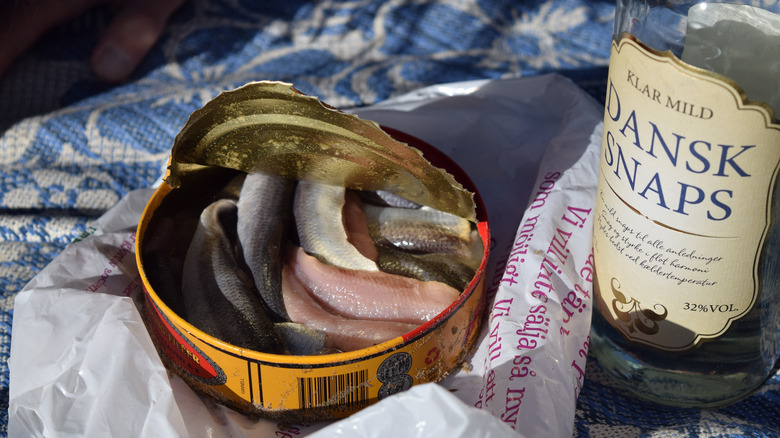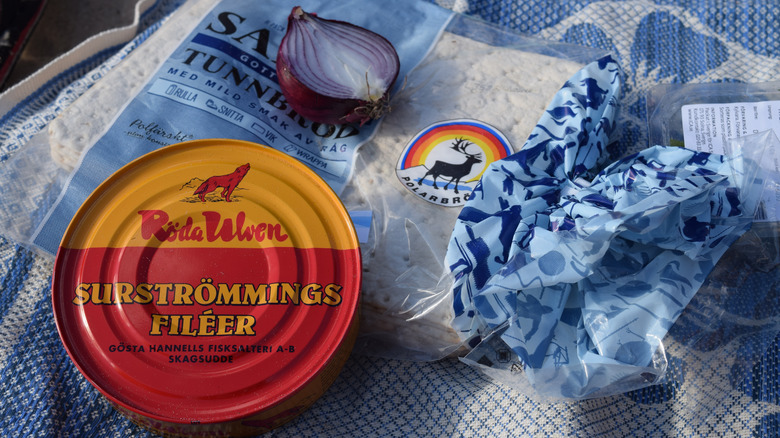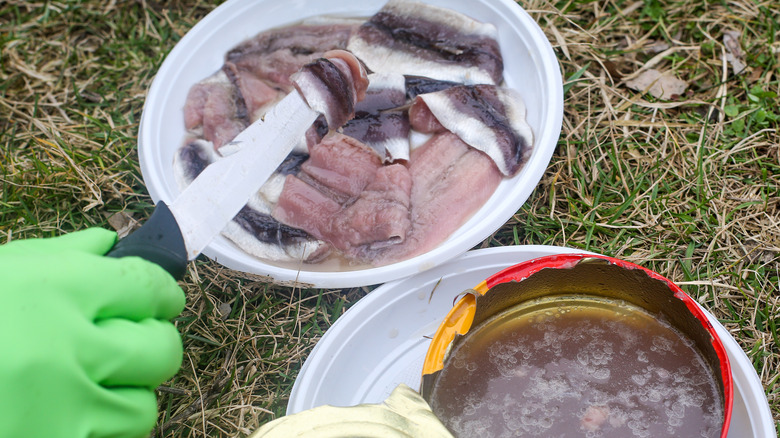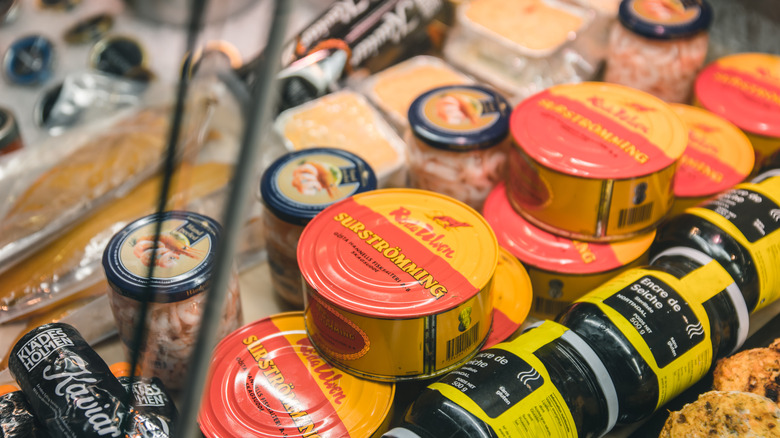Surströmming: Sweden's Incredibly Potent Canned Fish
Americans have a fickle, ambiguous relationship with canned or tinned fish. Canned tuna is a staple. Tuna salad being a go-to — if at times ill-received — meal for parents to whip up for hungry kids. The same goes for that suburban staple tuna noodle casserole, which for some, can churn up feelings of warmth and nostalgia, but for others, utter revulsion. And what self-respecting deli or diner doesn't have a tuna melt on the menu?
Of course, canned tuna is just one type of tinned fish available. There's also crab meat, albacore, sardines, and mackerel, and that's just scratching the surface. It would seem too that canned fish is having a moment. Despite being spurned by millennials just a few years back, young people are rediscovering the joys of canned fish and spreading the word via social media. Not only can tinned seafood contribute to a handsome board, but as a sustainable protein, it appeals to the environmentally conscious.
Speaking of culinary moments, fermentation is also having one, as a growing number of people are appreciating and seeking out the distinct flavors and health benefits of foods like sauerkraut, yogurt, and pickles. Distinctly posed to take advantage of the intersection of both canned fish and fermentation is a Swedish specialty that still might be a hard sell to some.
A challenging aroma
Surströmming is no stranger to the spotlight. According to Visit Sweden, It has frequently been the star of online videos bearing the name, "Stinky Fish Challenge." People frequently test their mettle, seeing if they can withstand the olfactory assault of surströmming. Fans of the fish promise that those who can see past a little stink are rewarded with a flavor that is "rounded yet piquant with a distinct acidity."
A can of surströmming starts out as Baltic herring, which, as far as sustainability goes, is one of the best fish you can eat. According to SwedishFood.com, from there the fish are packed whole in barrels of brine where lactic enzymes in the fishes' spines begin the fermentation process. After a few months in the barrel, the herring are packed into their cans, but they are not yet bound for stores. No, they must continue to ferment another six to 12 months, causing their cans to become distended and bulge.
How does surströmming taste?
But let's assume you're the adventurous type and in possession of both the can of surströmming and the desire to dig in. What should you expect? First, that smell is something that should be dealt with. If you are in a small, enclosed space with poor ventilation, you may want to think again or relocate to a more airy environment. The great outdoors is optimal as surströmming's scent tends to linger.
Now that the can is open and the smell has perfumed the air, it's time to dig in. Unadulterated surströmming, is an umami bomb with a hefty dose of salt and background pepperiness. Interestingly though, the fish take on from their lactic acid fermentation a pronounced cheesiness, not unlike gruyere, brie, or even sharp varieties like blue cheese.
Rarely do Swedes eat their surströmming plain, though. As Ateriet explains, slices are served on tunnbröd, a type of thin flatbread, along with sour cream, sliced potato, red onion, dill, chives, butter, and whatever else fits a diner's fancy. Another important decision is what to drink. While there are no wrong options, tradition leans toward crisp, light beers — think pilsner — or akvavit, a caraway seed-flavored spirit popular across Scandinavia.
Is surströmming good for you?
There's no denying that the consumption of surströmming is deeply connected with Swedish cultural heritage, and there is likely also some bravado wrapped up in eating a food that some find so unappealing. But that's not to say that there aren't actual benefits to downing fermented Baltic herring. According to a study published in the Journal of Ethnic Food, by weight, surströmming contains about 11.8 percent protein. What's more, as a fermented food, it has added beneficial properties.
Nutritionist Dr. Patrick Owen points out that fermented foods are frequently avoided because of their ripe flavors and odors, but that is a mistake for those seeking a well-rounded and "active" diet. "The main benefit of fermented meats is the beneficial bacteria that ends up beating out all the nasty bacteria during the fermentation process. The proper balance of bacteria in our gut is arguably the most important first step in ensuring optimal digestion, nutrient absorption and general well-being ... Forget what your nose is telling you. Listen to your gut; it's telling you to quaff down that rotting fish."
Getting your hands on surströmming
If you want to try surströmming and you're willing to travel, a great place to start would be Skeppsmalen, Sweden. Located on the Gulf of Bothnia, this fishing village is small, but it contains the Fiskevistet museum, where you can learn about the area and its fishing traditions as well as the history and production process behind the unique tinned fish. Then, mosey over to their restaurant for an order of fermented Baltic herring served with cooked potatoes, finely chopped onion, tomato, creme fraiche, butter, and tunnbröd for 319 krona (roughly $30, American).
If, however, you can't make it to Sweden, there are other options. A great (and obvious) place to start is surstromming.com, a shop that ships cans of surströmming around the globe. But be warned: a can doesn't come cheap, ranging from $59.99 to $69.99 a can. The site even sells surströmming challenge kits that include the fish as well as tunnbröd and Swedish sweets, such as extra-salty licorice svenskjӓvlar, which can run upwards of $100 before shipping.




